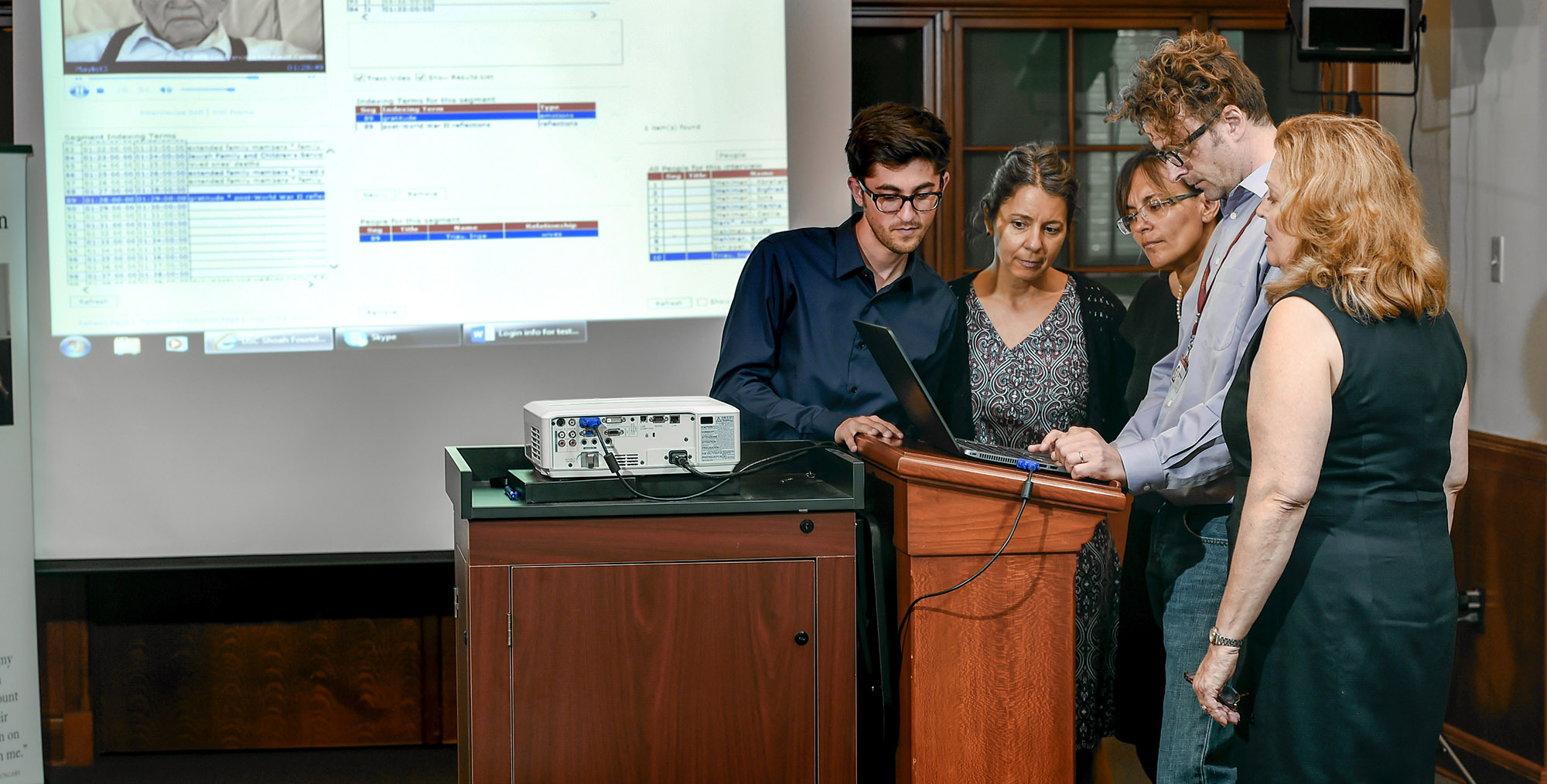Indexers Reunite to Index Last Testimony from JFCS Holocaust Collection

USC Shoah Foundation indexers Zach Albert, Debbie Kahn, Svetlana Ushakova and Nancy Saul gathered around a computer and peered at the last few minutes of the testimony of Holocaust survivor Ernest Mehlman.
Guided by Visual History Archive curator Crispin Brooks, their trainer and mentor for the last year and a half, they decided which keywords from the Visual History Archive thesaurus would most accurately describe the concluding moments of Mehlman’s testimony, in which he shows the camera a large poster of family photographs.
Then, satisfied with their work, they clicked “Submit.”
And just like that, indexing for USC Shoah Foundation’s Jewish Family and Children’s Services (JFCS) of San Francisco testimony collection was officially complete.
The JFCS collection is part of USC Shoah Foundation’s Preserving the Legacy initiative, in which several Holocaust survivor testimony collections from around the world will be integrated into the Visual History Archive. The JFCS collection contains about 1,400 testimonies that were collected in a variety of audiovisual formats in the Bay Area beginning in 1980.
USC Shoah Foundation’s indexing system allows users of the Visual History Archive to use 62,882 keywords and nearly 1.8 million names to search the archive’s 52,000 testimonies down to the minute. Typically, staff who are hired to index new collections have backgrounds in history, languages and/or library science and cataloging. Their job entails cataloging each testimony according to the interviewee's biographical information, and deciding which keywords most accurately describe what the interviewee is talking about in each minute of the testimony.
A small group of staff was hired in January 2014 to index the newly-acquired JFCS collection. After an initial training session on-site at USC Shoah Foundation’s office in Los Angeles, the indexers continued working full-time from home, using USC Shoah Foundation’s indexing software to each complete several hours of testimony per week.
On Thursday, Aug. 6, four of those indexers returned to USC Shoah Foundation to celebrate the conclusion of their work on the collection and to ceremoniously index the very last testimony together.
Gathered in the Feuchtwanger Memorial Library in USC’s Doheny Memorial Library, the group was welcomed by Scott Spencer, Project Manager of the Holocaust/WWII Audiovisual Collections for the Preserving the Legacy Initiative. Spencer noted that the job of indexing is normally a very solitary one – indexers work alone, in their offices, their kitchens, even their local library, perhaps – watching hours of Holocaust survivor testimony and completing their work independently. Though their work is vital to the usability of the Visual History Archive, they don’t often get to see the fruits of their labor.
To help the indexers understand the impact of their job, Spencer invited Professor Magarete Feinstein to speak to the group. Feinstein is a Holocaust researcher and avid user of the Visual History Archive. She described several research projects she has completed that would not have been possible without the powerful indexing of the Visual History Archive; for example, she used indexing terms to narrow down her search to survivors who describe feelings of distrust they had for their doctors and the quality of care they received when they became pregnant immediately after the war. She’s also researched liberation and survivors who discuss taking physical revenge after the war.
“It’s the index that makes [the archive] usable, makes [research] possible,” Feinstein said. Being here today, she said, was an opportunity to thank the indexers on behalf of all the researchers and educators who rely on indexing to shape what they find in the Visual History Archive.
As the group prepared to index the final moments of the last testimony, Spencer explained that he chose the testimony of Ernest Mehlman to close out the JFCS collection not because it was particularly unusual or unique, but because it was the kind of testimony the indexers worked with on a daily basis. It embodied the character of the whole collection, Spencer said: “real people and personal stories.”
Scholars, educators and students will get to see and experience the JFCS indexers’ finished work when the collection goes live in the Visual History Archive in the coming months.
Like this article? Get our e-newsletter.
Be the first to learn about new articles and personal stories like the one you've just read.